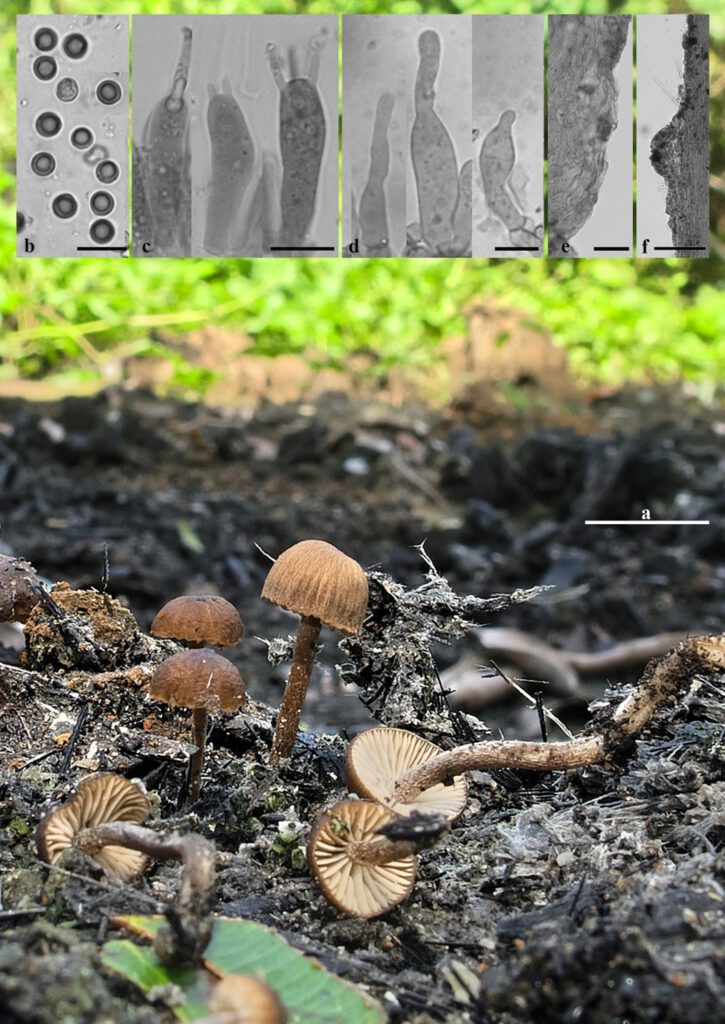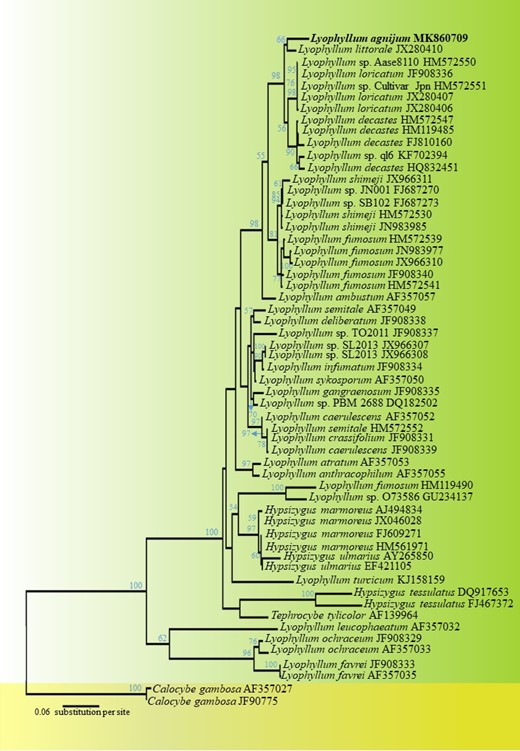Lyophyllum agnijum K. N. A. Raj, K. P. D. Latha & Manim.,
MycoBank number: MB 559692; Index Fungorum number: IF 559692; Facesoffungi number: FoF 10842;
Description (from holotype)
Basidiocarps small, omphalinoid. Pileus 3–8 mm diam., convex or hemispherical with a small, distinct umbo; surface greyish brown (6F3/OAC640) all over when young, becoming greyish brown at the centre (6F3/OAC640) and dark brown (6F5/OAC734) elsewhere, hygrophanous and becoming paler, finely striate, appressed-fibrillose all over; margin initially incurved, becoming decurved, crenate. Lamellae emarginate with a small decurrent tooth, close, greyish brown (6D2/OAC723) when young, becoming brownish grey (6C2/OAC669) at maturity, up to 3 mm wide, with lamellulae of 3 lengths; edge finely torn, concolourous with the sides. Stipe 9–40 × 1–2 mm, central, terete, equal or slightly tapering towards the base, fistulose; surface greyish brown (6F3/OAC640) when young, becoming light brown (6D4/OAC646), longitudinally fibrillose, white-furfuraceous at the apex; base slightly enlarged, whitish. Context up to 1 mm thick. Odour and taste not distinctive. Spore print not obtained.
Basidiospores 5–6(6.5) × 5–5.5(6.5) (5.47 ± 0.44 × 5.12 ± 0.27) µm, Q = 1–1.2, Qm = 1.06, subglobose to globose, smooth, cyanophilous, thin- to slightly thick-walled, inamyloid. Basidia 24–34 × 6.5–8 µm, clavate, hyaline, thin-walled, siderophilous, 1-, 2-, 4-spored; sterigmata up to 9 µm long. Pleurocystidia absent. Lamella-edge heterogeneous, fertile basidia intermixed with scarce, hard-to-detect cystidia. Marginal cells (Cheilocystidia) 10–28 × 3–7 µm, versiform: clavate, flexuose, narrowly utriform, filiform or sometimes septate, hyaline, thin-walled. Lamellar trama with a broad mediostratum composed of subregular compactly arranged hyphae, slightly but distinctly gelatinised towards the subhymenium; hyphae 3.5–11 µm wide, hyaline, thin-walled, inamyloid. Pileus trama subregular; hyphae 2–10 µm wide, hyaline, hyaline or with a pale yellow wall pigment, thin- to slightly thick-walled, inamyloid. Pileipellis a cutis; hyphae 3.5–17 µm wide, with yellowish brown wall pigment and yellowish brown spiral encrustations, thin- to slightly thick-walled. Stipitipellis a cutis disrupted by short trichodermial patches towards the apex; hyphae 3–8 µm wide, with a pale yellowish brown wall pigment. Terminal elements 22.5–44 × 4–7 µm, hyaline, thin- to slightly thick-walled. Caulocystidia absent. Clamp connections observed on all hyphae.
Material examined: INDIA, Kerala State, Wayanad District, Kuruva islets on the river Kabani, 06 July 2015, K. P. Deepna Latha & K. N. Anil Raj DKP356 (CAL 1388, holotype).
Distribution: known only from the type locality in Kerala State, India.
Sequence data: Sequence data from the holotype
ITS: MK860709
Notes: Lyophyllum ambustum (Fr.) Singer, another carbonicolous species distributed in Europe and also reported from India, seems to be close to L. agnijum in having brownish basidiocarps with an umbonate, hygrophanous pileus, rather similar-sized basidiospores (5.5–8 × 5–6.5 μm), hyphae of pileipellis with brown encrustations and a gregarious habit. However, L. ambustum has larger basidiocarps (pileus up to 20 mm diam., stipe 25–45 × 1.5–2.5 mm), a pileus which is translucent-striate, dry, almost whitish grey when mature and with a denticulate margin, broadly adnate lamellae with smooth edges, a stipe which is hollow when mature with white fibrous flakes, a flour-like odour, tuberculate-verrucose basidiospores, a lamella-edge without cystidia and the absence of clamp connections (Moser 1983; Breitenbach and Kränzlin 1991). Lyophyllum anthracophilum (Lasch) M. Lange & Sivertsen, a carbonicolous species reported from Europe, North America, Africa and Asia, is similar to L. agnijum in having brown-tinted basidiocarps with a striate, hygrophanous pileus, a longitudinally fibrillose stipe which is furfuraceous at the apex, globose to subglobose basidiospores, a pileipellis composed of parallel hyphae, the presence of clamp connections and a gregarious habit. Lyophyllum anthracophilum, however, is distinguished from L. agnijum by its larger basidiocarps (pileus up to 30 mm diam., stipe 30–50 × 1.5–2 mm) with black-brown pileus and stipe, a non-umbonate pileus which is applanate with age, broadly adnate to subdecurrent, grey-white lamellae with a smooth edge, smaller basidiospores (4.8–5.7 × 4.5–5.5 μm) and lamellae devoid of cystidia (Moser 1983; Breitenbach and Kränzlin 1991).
The closest hit of L. agnijum in the Blastn search was L. decastes. As is evident from our phylogenetic tree (Fig. 2), L. decastes is a species complex which includes several lineages and this has caused considerable taxonomic confusion in the past (Larsson and Sundberg 2011). Therefore, a morphology-based comparison with L. decastes is meaningless. In our analysis, L. agnijum was found paired with L. littorale (66% BS) representing a clade well-differentiated from L. decastes species complex with high bootstrap (98% BS) support. Lyophyllum littorale (Ballero & Contu) Contu, a species described from Sardinia, Italy, shares some characters such as close, decurrent lamellae, a fibrillose stipe with pruina restricted to the apex, globose to subglobose basidiospores of somewhat similar-size (4.5–6.3 × 4.5–5.7 μm), clamped hyphae and a gregarious habitat. However, L. littorale is distinguished from L. agnijum in having large (pileus 15–65 mm diam., stipe 20–60 × 4–8 mm), grayish basidiocarps fruiting on calcareous soil, a non-hygrophanous pileus with depressed centre and pruinose surface and is devoid of striations, a stipe which is tapered towards the apex and an orange-yellow base, 4-spored basidia and slightly gelatinised pileipellis (Ballero and Contu 1990).
Lyophyllum atratum, L. anthracophilum and L. ambustum, the other carbonicolous species treated in the present phylogenetic analysis, seem to be phylogenetically unrelated with L. agnijum.
Importance of species to humans or ecosystem: No data available
Quarantine significance: No data available
Biochemical importance of species: No data available
Chemical diversity or application: No data available

Fig. 1. Lyophyllum agnijum (CAL 1388, holotype). a Basidiocarps in their natural habitat. b Basidiospores. c Basidia. d Marginal cells. e Pileipellis. f Stipitipellis towards the apex of the stipe. Scale bars: a=10 mm, b-d = 10 µm, e-f= 20 µm (photos by K. N. Anil Raj & K. P. Deepna Latha).

Fig. 2. ML phylogeny based on nrITS sequence dataset depicting the placement of Lyophyllum agnijum. The newly sequenced species is displayed in bold face. ML bootstrap values are shown. Scale bar indicates the number of substitutions per site.
